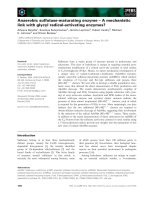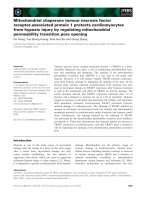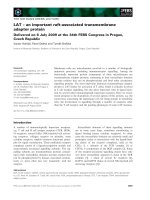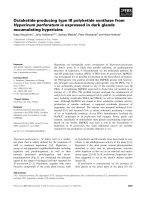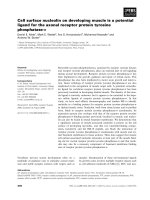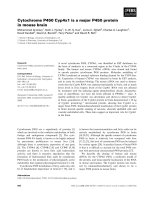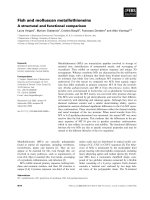Báo cáo khoa học: Cell death-inducing DFF45-like effector, a lipid droplet-associated protein, might be involved in the differentiation of human adipocytes pdf
Bạn đang xem bản rút gọn của tài liệu. Xem và tải ngay bản đầy đủ của tài liệu tại đây (613.33 KB, 11 trang )
Cell death-inducing DFF45-like effector, a lipid
droplet-associated protein, might be involved in the
differentiation of human adipocytes
Fanfan Li
1
,YuGu
1
, Wenpeng Dong
2
, Hang Li
1
, Liying Zhang
1
, Nanlin Li
3
, Wangzhou Li
4
,
Lijun Zhang
1
, Yue Song
1
, Lina Jiang
1
, Jing Ye
1
and Qing Li
1
1 State Key Laboratory of Cancer Biology, Department of Pathology, Xijing Hospital, Fourth Military Medical University, Xi’an, China
2 State Key Laboratory of Cancer Biology, Xijing Hospital of Digestive Diseases, Fourth Military Medical University, Xi’an, China
3 Department of Vascular and Endocrine Surgery, Xijing Hospital, Fourth Military Medical University, Xi’an, China
4 Department of Plastic and Burns, Tangdu Hospital, Fourth Military Medical University, Xi’an, China
Introduction
Over the past 50 years, mounting evidence has shown
that obesity-related diseases, such as type 2 diabetes
and cardiovascular disease, are serious health prob-
lems, which stimulated a surge of interest in the study
of adipocyte biology [1]. Owing to an imbalance
between energy intake and expenditure, obesity is often
characterized by an increase in both the size and the
number of adipocytes. Previous data have shown that
adipose tissues play crucial roles in the development
of obesity, and that the differentiation of adipocytes
Keywords
adipocyte differentiation; cell death-inducing
DFF45-like effector C (CIDEC); obesity;
peroxisome proliferator-activated receptor-c
(PPARc); RNAi
Correspondence
Qing Li and Jing Ye, State Key Laboratory
of Cancer Biology, Department of
Pathology, Xijing Hospital, Fourth Military
Medical University, 15# Changle West
Road, Xi’an 710032, China
Fax: 86 29 84776793
Tel: 86 29 84774541
E-mail: ;
(Received 12 March 2010, revised 29 July
2010, accepted 3 August 2010)
doi:10.1111/j.1742-4658.2010.07806.x
Cell death-inducing DFF45-like effector (CIDE) family proteins, including
cell death-inducing DFF45-like effector A (CIDEA), cell death-inducing
DFF45-like effector B (CIDEB) and cell death-inducing DFF45-like effec-
tor C (CIDEC) [fat-specific protein of 27 kDa in rodent (FSP27) in
rodents], were originally identified by their sequence homology to the
N-terminal region of DNA fragmentation factor DFF40 ⁄ 45. Recent reports
have revealed that CIDE family proteins play important roles in lipid
metabolism. Several studies involving knockdown mice revealed that
FSP27 is a lipid droplet-targeting protein that can promote the formation
of lipid droplets. However, the detailed roles of human CIDEC in the dif-
ferentiation of human adipocytes remain unknown. In the present study,
we found that the expression of CIDEC increased during the differentiation
of fetal adipose tissues, but decreased during the de-differentiation of adip-
ocytic tumors, suggesting that the expression of CIDEC should be posi-
tively correlated with the differentiation of adipocytes. Furthermore, we
verified that human CIDEC was localized on the surface of lipid droplets.
Using human primary pre-adipocytes, we confirmed that the expression of
CIDEC was elevated during the differentiation of pre-adipocytes, and
knockdown of CIDEC in human primary pre-adipocytes resulted in differ-
entiation defects. These data demonstrate that CIDEC is essential for the
differentiation of adipose tissue. Together with regulating adipocyte lipid
metabolism, CIDEC should be a potential target for regulating adipocyte
differentiation and reducing fat cell mass.
Abbreviations
CIDEC, cell death-inducing DFF45-like effector C; EGFP, enhanced green fluorescent protein; FSP27, fat-specific protein of 27 kDa; FABP,
fatty acid-binding protein; GAPDH, glyceraldehyde-3-phosphate dehydrogenase; HA, hemagglutinin; PPARc, peroxisome proliferator-activated
receptor-c; shRNA, short hairpin RNA; TG, triglyceride.
FEBS Journal 277 (2010) 4173–4183 ª 2010 The Authors Journal compilation ª 2010 FEBS 4173
is closely linked to obesity and obesity-related dis-
eases [2]. Therefore, to understand obesity in greater
detail, it is critical to elucidate the physiological role
of adipose tissue and the mechanism of adipocyte dif-
ferentiation, particularly during embryonic and fetal
life [3].
Cell death-inducing DFF45-like effector (CIDE) pro-
teins, including cell death-inducing DFF45-like effector A
(CIDEA), cell death-inducin g DFF45-like e ffector (CIDEB)
and cell death-inducing DFF45-like effector (CIDEC)
[also known as fat-specific protein of 27 kDa (FSP27)
in rodents], were originally identified by their
sequence homology to the N-terminal region of
DNA fragmentation factor DFF40 ⁄ 45 [4,5]. Animals
deficient in CIDEA, CIDEB or FSP27 display lean
phenotypes with higher energy expenditure and are
resistant to diet-induced obesity [6–8], suggesting a
universal role of CIDE proteins in the regulation of
energy homeostasis. FSP27, the rodent homolog of
human CIDEC, was first identified in differentiated
TA1 adipocytes. Peroxisome proliferator-activated
receptor-c (PPARc) and CCAAT ⁄ enhancer-binding
protein, key regulators during adipose differentiation,
play critical roles in regulating the transcription of
Fsp27 [9]. Over-expression of FSP27 in 3T3-L1
pre-adipocytes as well as in COS-7 cells markedly
increases the size of lipid droplets and enhances the
accumulation of total neutral lipids [10,11], both of
which are characteristics of mature adipocytes. When
Fsp27 was depleted during adipogenesis or in differenti-
ated 3T3-L1 cells, the lipid droplets were uniformly
dispersed into smaller structures, and lipolysis was
modestly increased [10,11].
Although CIDEC, is 66% homologus to FSP27, the
functional phenotypes of the two proteins are not fully
consistent. For example, there is an obvious difference
of insulin sensitivity between human CIDEC and
mouse FSP27 [12–14]. Therefore, it is necessary to
study the function of CIDEC in humans. In this
research, we examined the role of CIDEC in human
adipocyte differentiation. We observed that CIDEC
was expressed at increasingly higher levels during the
differentiation of fetal adipose tissues and expressed at
decreasingly lower levels during the de-differentiation
of adipocytic tumors, suggesting that the expression of
CIDEC should be positively correlated with the differ-
entiation of adipocytes. We also verified that CIDEC
was localized on the surface of lipid droplets. In
human primary pre-adipocytes, we confirmed that the
expression of CIDEC was elevated during the differen-
tiation of adipocytes. Furthermore, stable knockdown
of CIDEC during adipogenesis of human primary pre-
adipocytes resulted in differentiation defects.
Results
CIDEC is increasingly expressed during the differ-
entiation of fetal adipose tissues
To investigate the expression of CIDEC in fetal adi-
pose tissues at different stages of development, paraf-
fin-embedded fetal adipose tissue samples were
analyzed by immunohistochemistry using an affinity-
purified antibody of human CIDEC. As shown in
Fig. 1A, CIDEC was strongly expressed in adipose tis-
sues obtained from third-trimester (week 33 of gesta-
tion) fetal samples, which were already composed of
mature adipocytes that contained large unilocular lipid
droplets occupying most of the cytoplasm. However,
CIDEC was not readily detected in second-trimester
(weeks 18 and 23 of gestation) fetal samples, which
contained undifferentiated pre-adipocytes. Western
blotting and real-time PCR analyses showed that both
the protein and the mRNA levels of CIDEC were
markedly increased in adipose tissues of third-trimester
fetal samples (Fig. 1B,C), which was consistent with
the immunohistochemistry result.
As an important regulator in adipogenesis, PPARc
also plays a key role in maintaining the characteristics
of mature adipocytes, and recent reports revealed that
PPARc was required for the transcriptional activity of
CIDEC during adipogenesis [15]. We also observed
that the mRNA and protein levels of PPARc were
markedly increased during the differentiation of fetal
adipose tissues (Fig. 1B,C,D), which paralleled the
increased expression of CIDEC. These results suggest
that the expression of CIDEC in fetal adipose tissues
should be correlated with the differentiation or matu-
ration of adipocytes.
Expression of CIDEC decreases with
de-differentiation of adipocytic tumors
The expression of CIDEC, which increased with the
maturation of fetal adipose tissues, prompted us to
investigate the relationship between CIDEC and dif-
ferentiation in adipocyte-derived tumors (lipoma and
liposarcoma). Thirty normal adipose tissue specimens,
15 lipoma specimens and 30 liposarcoma specimens
were collected using routine procedures. Immunohis-
tochemical staining showed that CIDEC was present
in all normal adipose tissue and lipoma specimens.
Interestingly, lower levels of CIDEC were detected in
all 15 well-differentiated liposarcoma specimens. How-
ever, CIDEC was undetectable in the 10 myxoid lipo-
sarcoma specimens and in the five de-differentiated
liposarcoma specimens. Figure 2A shows representative
CIDEC in human adipocyte differentiation F. Li et al.
4174 FEBS Journal 277 (2010) 4173–4183 ª 2010 The Authors Journal compilation ª 2010 FEBS
slides demonstrating the CIDEC-staining patterns in
normal adipose tissues and adipocytic tumors. Using
quantitative PCR, lower CIDEC mRNA transcript
levels were found in well-differentiated liposarcomas,
and the mRNA levels of CIDEC were almost unde-
tectable in myxoid liposarcomas or de-differentiated
liposarcomas (Fig. 2B). Furthermore, the decreased
levels of CIDEC, found in liposarcomas differentiated
to various degrees, were confirmed by immunoblot-
ting (Fig. 2C,D). These results indicated that higher
levels of CIDEC are present in normal fat tissue and
in well-differentiated adipocytic tumors than in poorly
differentiated adipocytic tumors, indicating that the
expression of CIDEC decreases along with the de-dif-
ferentiation of adipocytic tumors. In summary, these
results imply that CIDEC could be involved in the
differentiation of adipocytes.
CIDEC localizes on the surface of lipid droplets
In order to evaluate the subcellular localization of
human CIDEC, COS-7 cells were transfected with a
vector that expressed a fusion protein of CIDEC con-
taining the fluorescence marker DsRed1. The transfect-
ed COS-7 cells were cultured for 24 h in the presence of
100 lm oleic acid to promote the enlargement of lipid
droplets. As shown in Fig. 3A, CIDEC was localized to
strikingly different spherical structures, and the spheri-
cal structures of CIDEC surrounded the lipid droplets,
as visualized by staining with Bodipy 493 ⁄ 503. More-
over, the plasmid expressing enhanced green fluorescent
protein (EGFP)-tagged adipophilin (also named perili-
pin-2) was co-transfected into COS-7 cells with a plasmid
containing hemagglutinin (HA)-tagged CIDEC. We
observed that CIDEC could partly overlap with EGFP-
A
abc
B
CD
Fig. 1. Expression of CIDEC increased during the differentiation of fetal adipose tissue. (A) Immunohistochemical staining was used to
determine the expression of CIDEC in fetal adipose tissues obtained at weeks 18 (a), 23 (b) and 33 (c) of gestation (scale bar = 25 lm). The
expression of CIDEC increased along with the differentiation of adipose tissue, and the highest level of expression of CIDEC was detected
in mature adipose tissue. (B) Real-time PCR analysis of CIDEC and PPARc in different developmental stages of fetal adipose tissue. The rela-
tive mRNA levels of CIDEC and PPARc in fetal adipose tissue obtained at week 33 of gestation were higher than in that obtained at weeks
18 and 23 of gestation. (The relative mRNA level in fetal adipose tissue obtained at week 18 of gestation was designated as 1.0. n =3,
*P<0.05, **P<0.01) (C) Immunoblot analysis of CIDEC and PPARc in fetal adipose tissues showed a higher level of expression of these
proteins in mature adipose tissue. GAPDH was used as loading control. (D) The relative quantity of CIDEC and PPARc protein was analyzed
using
QUANTITY ONE software (Bio-Rad). (The relative level of protein in the 18th week of gestation was designated as 1.0. n =3,*P<0.05,
**P<0.01).
F. Li et al. CIDEC in human adipocyte differentiation
FEBS Journal 277 (2010) 4173–4183 ª 2010 The Authors Journal compilation ª 2010 FEBS 4175
tagged adipophilin, a lipid droplet-targeting protein
(Fig. 3B). These data indicate that only a small amount
of CIDEC was localized on the surface of lipid drop-
lets, suggesting that CIDEC is also likely to be localized
on subcellular compartments other than lipid droplets.
The expression of CIDEC is elevated during the
differentiation of adipocytes
To gain further insight into the roles of CIDEC in
adipocyte differentiation, human primary pre-adipo-
cytes were successfully isolated and cultured in vitro.
The pre-adipocytes were induced using adipogenic
cocktails upon reaching confluence. After 14 days of
induction, the majority of the cells displayed a phe-
notype of mature adipocytes (Fig. 4A). The neutral
lipids accumulated in the cytoplasm, and a large
number of lipid droplets were observed after staining
the cells with Oil Red O (Fig. 4B). Concurrently,
CIDEC was detected in adipocytes from day 3 and
showed an increase during the course of differentia-
tion, reaching a peak on day 14. Furthermore, as a
key regulator of adipogenesis, PPARc was also
detected in adipocytes on day 3 during differentia-
tion (Fig. 4D). Using quantitative PCR, we observed
that the mRNA levels of CIDEC and PPARc were
significantly increased in adipocytes during the differ-
entiation of pre-adipocytes (Fig. 4C), which was con-
sistent with the change of protein levels. These data
suggest that the expression of CIDEC might be
attributable to the differentiation or maturation of
adipocytes.
A
a
b
c
d
e
B
C
D
Fig. 2. Expression of CIDEC in normal adi-
pose tissues, lipomas and liposarcomas.
(A) immunohistochemical staining for CIDEC
showed that it was present in normal adi-
pose tissue (NAT) (a) and lipoma (b). How-
ever, only low levels of CIDEC could be
detected in well-differentiated liposarcomas
(WDLPS) (c), and no CIDEC was detectable
in myxoid liposarcomas (MLPS) (d) or de-dif-
ferentiated liposarcomas (DDLPS) (e) (scale
bar = 50 lm). (B) Real-time PCR revealed
that the relative mRNA levels of CIDEC
were higher in normal adipose tissue and
lipoma than in liposarcoma (The relative
mRNA level of NAT was designated as 1.0,
***P<0.001). (C) Western blot analysis
showed that the levels of CIDEC protein
were high in normal adipose tissue and
lipoma, but lower or negative in liposarco-
ma. GAPDH was used as the loading
control. (D) The relative quantity of CIDEC
protein was analyzed using
QUANTITY ONE
software (The relative protein level of NAT
was designated as 1.0, **P<0.01
***P<0.001).
CIDEC in human adipocyte differentiation F. Li et al.
4176 FEBS Journal 277 (2010) 4173–4183 ª 2010 The Authors Journal compilation ª 2010 FEBS
A
B
Fig. 3. CIDEC localizes on the surface of lipid droplets in COS-7. (A) COS-7 cells transfected with DsRed1-tagged CIDEC (red, middle panel)
were incubated with 100 l
M oleic acid for 24 h to enlarge the lipid droplets, which were visualized by Bodipy 493 ⁄ 503 staining (green, left
panel). In the merged image (right panel), DsRed1-tagged CIDEC formed annular structures around the lipid droplets, suggesting that CIDEC
should localize on the surface of lipid droplets. Nuclei were labeled with Hochest 33258. (B) COS-7 cells were co-transfected with
HA-tagged CIDEC and EGFP-tagged adipophilin. Indirect immunofluorescence showed the co-localization of CIDEC with adipophilin, a lipid
droplet-targeting protein. Nuclei were stained with Hochest 33258. Scale bar = 10 lm.
A
B
CD
E
Fig. 4. The expression of CIDEC increased
during the differentiation of human primary
pre-adipocytes. (A) Lipid droplets were
detectable in human differentiated pre-
adipocytes in phase-contrast micrographs
(Scale bar = 10 lm). (B) The lipid droplets in
differentiated pre-adipocytes were visualized
using Bodipy staining (scale bar = 10 lm).
(C) The mRNA levels of CIDEC and PPARc
were assessed using quantitative PCR.
Significantly higher levels of CIDEC and
PPARc were detected on days 7 and 14
during the differentiation of adipocytes (The
relative mRNA level before differentiation
(day 0) was designated as 1.0. *P<0.05,
**P<0.01, ***P<0.001). (D) Immunoblot
analysis revealed that the expression of
CIDEC increased in human pre-adipocytes
during differentiation, and the expression of
PPARc showed a similar pattern. FABP was
used as an adipocyte differentiation marker.
(E) Densitometric analyses of the relative
levels of the indicated proteins after wes-
tern blotting (as in D) were carried out. Simi-
lar experiments were performed five times
and the intensity of the individual bands in
each western blot was quantified by
QUANTITY ONE software and used for statistical
analysis (The relative protein level before dif-
ferentiation (0 day) was designated as 1.0.
**P<0.01, ***P<0.001).
F. Li et al. CIDEC in human adipocyte differentiation
FEBS Journal 277 (2010) 4173–4183 ª 2010 The Authors Journal compilation ª 2010 FEBS 4177
Knockdown of CIDEC in pre-adipocytes results in
differentiation defects
To investigate the effects of endogenous CIDEC on
lipid droplet morphology, lipid metabolism and the
maturation of lipid droplets, the pre-adipocytes were
infected with a lentivirus carrying the U6 promoter-
driven CIDEC short hairpin RNA (shRNA) before
induction of differentiation. Using western blot analy-
sis, we found that the shRNA specific for CIDEC
resulted in the loss of at least 90% of CIDEC in
adipocytes (Fig. 5A). This depletion of CIDEC
resulted in the formation of numerous small lipid
droplets in adipocytes during adipogenesis, in contrast
to the fewer and larger lipid droplets present in control
cells (Fig. 5B). Furthermore, when analyzed using
TLC, the triglyceride (TG) content of CIDEC-depleted
adipocytes was found to be significantly lower than
that of control adipocytes (Fig. 5C). To determine the
rate of lipolysis, the amount of glycerol released into
the medium was measured under basal conditions and
after stimulation with isoproterenol, and the results
revealed that the rate of lipolysis was significantly
increased in CIDEC-depleted adipocytes compared
with control adipocytes (Fig. 5D). Additionally,
we performed quantitative PCR analysis on several
A
B
C
D
E
Fig. 5. Depletion of CIDEC could block the differentiation of pre-adipocytes. (A) Immunoblot analysis revealed that the expression of CIDEC
was significantly reduced (by at least 90%) in differentiated human adipocytes infected with lentivirus-carrying CIDEC shRNA. (B) The lipid
droplets were fragmentated in the adipocytes with knockdown CIDEC after 14 days of differentiation (right panel) compared with the control
group (left panel). The lipid droplets were stained with Nile Red (red stain). Nuclei were stained with Hochest 33258 (blue stain) (scale
bar = 10 lm). (C) The amount of TG in differentiated adipocytes was quantified using TLC. A lower concentration of TG was found in
CIDEC-depleted adipocytes compared with control cells. (n =4,**P<0.01, ***P<0.001) (D) Glycerol released from control and CIDEC-
depleted adipocytes was assessed under basal conditions and after stimulation with isoproterenol for 1 h. (n =4, **P<0.01,
***P<0.001). (E) The mRNA levels of PPARc, adipophilin, FABP and perilipin and were assessed using quantitative PCR. The results
revealed that the mRNA level of adipophilin was not changed, the mRNA levels of perilipin and FABP were decreased and the mRNA level
of PPARc was increased in CIDEC-silenced adipocytes, compared with mature adipocytes. (The relative mRNA level in the control group
was designated as 1.0. n =3,*P<0.05, **P<0.01, ***P<0.001).
CIDEC in human adipocyte differentiation F. Li et al.
4178 FEBS Journal 277 (2010) 4173–4183 ª 2010 The Authors Journal compilation ª 2010 FEBS
molecules involved in adipocyte differentiation and
lipid droplet formation on day 14 after induction. As
lipid droplet-targeting proteins, perilipin and fatty
acid-binding protein (FABP) are expressed at late and
mature stages of lipid droplet formation. Interestingly,
we found that the mRNA level of adipophilin was not
changed, whereas the mRNA levels of perilipin and
FABP decreased, and the mRNA level of PPARc
increased, in CIDEC knockdown adipocytes, com-
pared with control adipocytes (Fig. 5E). These data
demonstrate that CIDEC can contribute to the accu-
mulation of neutral lipid and the maturation of lipid
droplets, which are key features of differentiated
adipocytes. Loss of CIDEC led to immature morphol-
ogy, reduction of TG accumulation, increased lipolysis
and impeded the maturation of lipid droplets, suggest-
ing important roles of CIDEC during the differentia-
tion of pre-adipocytes.
Discussion
The differentiation of adipocytes is the process of for-
mation of new adipocytes from pre-adipocyte precur-
sors, and is accompanied by the up-regulation of genes
encoding proteins critical for lipid synthesis, lipolysis,
lipid transport, insulin sensitivity and other adipocyte
functions. These proteins include PPARc, FABP, fatty
acid synthetase, fatty acid tran sporter an d ho rmone-sensitive
lipase [16]. PPARc has been identified as an important
adipogenic regulator ⁄ switch and provides dynamic
and specific regulation during the differentiation of
pre-adipocytes into mature adipocytes [17].
With regard to embryonic development of adipose
tissue, studies have shown that the first traces of adi-
pose tissue are detectable between the 14th and 16th
weeks of gestation in humans, and that the second tri-
mester of gestation is the critical period in adipogenesis.
After the 23rd week of gestation, although the number
of fat cells remains constant, the size of the lobules
grows and then multilocular adipocytes appear [18,19].
To our knowledge, we are the first group to present
data on the role of CIDEC in adipocyte differentiation
in vivo, which is evidenced by the increased expression
of CIDEC in third-trimester fetal adipose tissue sam-
ples, as well as the decreased expression of CIDEC in
conjunction with the de-differentiation of adipocytic
tumors. To further confirm that the expression of
CIDEC correlates positively with adipocyte differentia-
tion, human primary pre-adipocytes were stimulated to
differentiate into mature adipocytes, and the expression
of CIDEC gradually increased along with the expres-
sion of PPARc and FABP, which are important
molecules involved in adipocyte differentiation.
Although Liang et al. [5] have reported finding
CIDEC in an aggregated form near some mitochondria,
and staining of CIDEC with Golgi-, endoplasmic retic-
ulum- or lysosome-specific markers showed no over-
lapping staining, the exact localization of CIDEC still
remains to be clarified. In this study, we observed that
CIDEC was present on the surface of lipid droplets as
well as diffuse within COS-7 cells, which is similar to
the results observed in 3T3-L1 pre-adipocytes [14].
Notably, a recent study has demonstrated that FSP27
co-localizes with the endoplasmic reticulum-specific
protein CB5 in 3T3-L1 adipocytes [20]. Consequently,
these results suggest that CIDEC may be a lipid drop-
let-associated protein and might localize on other sub-
cellular compartments besides lipid droplets.
Adipogenesis, a component of morphogenesis, may
be defined in general terms as the proliferation and
subsequent differentiation of the fat-cell lineage capa-
ble of the assimilation of lipid to form a lipid-contain-
ing adipocyte [21]. Our results revealed that the
depletion of CIDEC resulted in increased lipolysis and
decreased consumption of TG in adipocytes during
adipogenesis. Furthermore, morphological observation
revealed that the depletion of CIDEC resulted in the
formation of numerous smaller lipid droplets in adipo-
cytes during adipogenesis. Thus, we speculated that
CIDEC is essential for the formation and maturation
of lipid droplets in adipocytes.
In addition, the roles of proteins that associate with
lipid droplets during adipogenesis, such as PAT pro-
teins (named after the founding members of the family:
perilipin, adipophilin ⁄ adipocyte differentiation-related
protein and TIP47), are of great interest. It is believed
that different lipid droplet-targeting proteins are
coated on lipid droplets at different stages of adipo-
genesis. At early stages, the droplets are coated with
adipophilin; however, during maturation, perilipin dis-
places adipophilin [22]. We found that the mRNA level
of adipophilin remained unchanged, while that of per-
ilipin was decreased in CIDEC-silenced adipocytes. It
can be concluded that knockdown of CIDEC in pre-
adipocytes results in defects of the maturation of lipid
droplets and impedes adipocyte differentiation because
maturation of lipid droplets is an important phenotype
of differentiated adipocytes.
It is noteworthy that we observed an up-regulation
of PPARc in human primary pre-adipocytes with
CIDEC knockdown. A previous study showed that
Fsp27 might be a direct mediator of PPARc-dependent
hepatic steatosis and identified a PPARc-specific cis-
element on the Fsp27 promoter [23]. Recently, it was
found that the thiazolidinedione, BRL49653, an ago-
nist of PPARc, increases the abundance of Fsp27
F. Li et al. CIDEC in human adipocyte differentiation
FEBS Journal 277 (2010) 4173–4183 ª 2010 The Authors Journal compilation ª 2010 FEBS 4179
mRNA in 3T3-L1 adipocytes, whereas the expression
of a dominant-negative mutant of PPARc results in a
decrease in the amount of Fsp27 mRNA in 3T3-L1
adipocytes [24]. Furthermore, our study found that
CIDEC and PPARc are expressed at increased levels
during the differentiation of fetal adipose tissues and
with the maturation of human primary adipocytes,
suggesting that CIDEC might be a target of PPARc
transactivation. These data suggest that CIDEC may not
only be a downstream target of PPARc transactivation,
but is also likely to be involved in a feedback-sensing
pathway. The results obtained using the Fsp27-knockout
mice also revealed that the expression of PPARc was
significantly increased [13], as was multilocular lipid
droplet formation, enhanced mitochondrial biogenesis
and glucose and free fatty acids oxidation, in white
adipose tissue [24]. The increased levels of intracellular
fatty acids may stimulate the expression of PPARc in
white adipose tissue and thereby induce the secondary
mitochondrial biogenesis [24,25]. Therefore, further
studies are necessary to characterize the physical inter-
actions between CIDEC and other lipid droplet-associ-
ated proteins, and to confirm the pathway through
which CIDEC affects the expression of PPARc, espe-
cially in humans.
In summary, we found that CIDEC was expressed
at increased levels in mature and differentiated adipose
tissues, but at decreased levels in de-differentiated adi-
pose tumors. It was demonstrated that CIDEC plays
important roles in the differentiation of adipose tissue
and in the regulation of adipocyte lipid metabolism,
indicating the potential of CIDEC as a target to inhi-
bit adipocyte differentiation, reduce fat cell mass and
improve insulin sensitivity.
Materials and methods
Samples of human tissues and cell lines
Fetal adipose tissue samples were obtained from nine still-
born fetuses at weeks 18, 23 and 33 of gestation (three
samples at each time-point) under the agreement of the
local Ethics Committee and after obtaining informed con-
sent. The causes of death were fetal distress caused by
eclampsia in four cases, and congenital heart disease in
five cases. The fetal body weights were, respectively, 537,
490, 598, 780, 860, 1028, 1432, 1350 and 1890 g. Samples
of normal adipose tissue (n = 30), and of lipoma
(n = 15) and liposarcoma (15 well-differentiated liposarco-
mas, 10 myxoid liposarcomas and five de-differentiated
liposarcomas) specimens were obtained from Xijing Hospi-
tal, the first affiliated hospital of the Fourth Military
Medical University (Xi’an, China). The patients (39 men
and 36 women) had a mean age of 38 (range: 17-69)
years. The human pre-adipocytes were isolated from
human subcutaneous adipose tissue obtained from five
patients [35.4 ± 2.2 years of age, body mass index (BMI):
27.2 ± 1.4 kgÆm
)2
] undergoing abdominal liposuction
treatment at the Department of Plastic and Burns, Tangdu
Hospital, the second affiliated hospital of the Fourth Mili-
tary Medical University. The Ethics Committee of the
hospital approved this study, and informed consent was
obtained from the patient. The COS-7 and 293T cells were
obtained from the Cell Bank of the Chinese Academy of
Sciences (Shanghai, China).
Isolation and induction of pre-adipocytes
Pieces of adipose tissue were immediately digested with
1mgÆmL
)1
of collagenase (Sigma-Aldrich, St Louis, MO,
USA) in D-Hank’s solution and incubated in 500 mL flask
on a shaker (Thermo ⁄ Forma Scientific 420 Incubator Orbi-
tal Tabletop Shaker, 200 rpm, 37 °C, 30 min). The digested
adipose tissue was filtered through a 150-lm cell strainer,
and the floating adipocytes were separated from the med-
ium containing the stroma-vascular fraction by centrifuga-
tion for 10 min at 3000 rpm. Centrifugalization separated
adipocytes from the stroma-vascular fraction that contained
pre-adipocytes (pellet). The stromal vascular pellets were
incubated with DMEM ⁄ F12 (Invitrogen/Gibco, Carlsbad,
CA, USA) supplemented with 10% fetal bovine serum
(Invitrogen/Gibco, Carlsbad, CA, USA). Two days after
reaching confluence, the medium was replaced with a
serum-free adipogenic medium (DMEM ⁄ F12 supplemented
with 10 lgÆmL
)1
of transferrin, 33 l m biotin, 0.5 l m insu-
lin, 0.2 nm triiodothyronine, 0.5 mm 3-isobutyl-1-methyl-
xanthine, 0.1 lm hydrocortisone and 17 lm pantothenate).
After incubation for a further 2 days, the medium was
replaced with the above-mentioned serum-free adipogenic
medium minus 3-isobutyl-1-methylxanthine. Cells were col-
lected at the indicated days of differentiation and used for
further experiments.
Plasmids and transfections
CIDEC plasmid DNA was amplified from the HepG2
cell line using the RT-PCR. After cutting with the
enzymes (NdeI and BamHI), the purified PCR fragment
was cloned into the vector pCMV5-HA (a gift from Dr
Peng Li, Tsinghua University). The recombinant vector
pShuttle-CMV-DsRed1-CIDEC was constructed by insert-
ing the DsRed1 and CIDEC DNA fragments into the
vector pShuttle-CMV. The plasmid pGFP-adipophilin was
also a kind gift from Dr Peng Li. The plasmids were
transfected into COS-7 cells using LipofectamineÔ (Invi-
trogen, USA) and about 10% of the cells were DsRed1-
positive.
CIDEC in human adipocyte differentiation F. Li et al.
4180 FEBS Journal 277 (2010) 4173–4183 ª 2010 The Authors Journal compilation ª 2010 FEBS
Immunofluorescence assay
Immunofluorescence analyses were carried out on cells
grown on cover-slips. The cells were fixed, for 20 min at
room temperature in NaCl ⁄ P
i
containing 3% paraformalde-
hyde, permeabilized for 15 min in NaCl ⁄ P
i
containing 0.1%
saponin, then incubated with HA antibody (sc-7392; Santa
Cruz Biotechnology, Santa Cruz, CA, USA) for 1 hour at
room temperature. Intracellular lipids were visualized with
1 lgÆmL
)1
of Bodipy 493 ⁄ 503. Fluorescence imaging was
assessed using confocal microscopy (Olympus FV1000,
Tokyo, Japan).
Quantitative PCR
Total RNA was extracted from tissues and cells using TRIzol
(Invitrogen). cDNA was synthesized from total RNA using
the PrimeScriptÔ RT reagent Kit (TAKARA, Dalian,
China). The mRNA levels were analyzed by real-time PCR
performed with the Bio-Rad iQ4 Multicolor Real-time iCy-
cler (Bio-Rad Laboratories, CA, USA) using SYBR
Ò
Premix
Ex TaqÔ (Takara). The primers (sense and antisense, respec-
tively) were as follows: CIDEC, 5¢-TTGATGTGGCCCGT
GTAACGTTTG-3¢ and 5¢-AAGCTTCCTTCATGATGCG
CTTGG-3¢; PPARc,5¢-TGGAATTAGATGACAGCGAC
TTGG-3¢ and 5¢-CTGGAGCAGCTTGGCAAACA-3¢;glyc-
eraldehyde-3-phosphate dehydrogenase (GAPDH), 5¢-AAC
ATCATCCCTGCCTCTAC-3¢ and 5¢-CTGCTTCACCACC
TTCTTG-3¢; perilipin, 5¢-CCTGCCTTACATGGCTTGTT-3¢
and 5¢-CCTTTGTTGACTGCCATCCT-3¢; and adipophilin,
5¢-CTGAGCACATCGAGTCACATACTCT-3¢ and 5¢-GGA
GCGTCTGGCATGTAGTGT-3¢.
Western blot analysis
Total protein lysate from frozen tissues or cultured cells was
prepared in ice-cold RIPA buffer (20 mm Hepes pH 7.5,
150 mm NaCl, 1 mm EDTA, 10% glycerol, 0.5% sodium de-
oxycholate, 1% Nonidet P-40, 0.1% SDS and protease inhib-
itor cocktails). Protein samples were immunoblotted with
antibodies to CIDEC, PPARc (Santa Cruz Biotechnology,
Santa Cruz, CA, USA), perilipin (Sigma-Aldrich, St Louis,
MO, USA), adipophilin (Progen, Heidelberg, Germany),
FABP (Alpha Diagnostic, San Antonio, TX, USA) and
GAPDH (Abcam, Cambridge, UK), and the protein–anti-
body immune complexes were detected with horseradish per-
oxidase-conjugated secondary antibodies and enhanced
chemiluminescence reagents (Pierce Biotechnology, Rock-
ford, IL, USA). The polyclonal antibodies against CIDEC
were generated by injection of rabbits with purified CIDEC
proteins (amino acids 1–172), as previously described [26].
The antibodies generated in response to the fusion protein
were purified by affinity chromatography with cyanogen bro-
mide-activated Sepharose 4B (Amersham Biosciences Corp.,
Piscataway, NJ, USA) coupled to the fusion protein.
Immunohistochemistry
Immunohistochemistry was carried out as previously
described [27]. Briefly, the deparaffinized and rehydrated
slides were blocked with 50 mLÆL
)1
of fetal bovine serum
for 30 min to reduce nonspecific binding. Then, incubate
slides in a humidified chamber at 4 °C overnight with
CIDEC antibody (1:200). Negative controls were obtained
by replacing the primary antibody with nonimmune rabbit
serum. The sections were subsequently incubated with the
second antibody (Dako, Copenhagen, Denmark) at 37 °C
for 40 min, and stained with 3,3¢-Diaminobenzidine-H
2
O
2
for 5–10 min and counterstained with hematoxylin.
Depletion of CIDEC in pre-adipocytes
The 21-nucleotide shRNA constructs, targeting CIDEC
mRNA, were designed using siRNA target finder soft-
ware ( />finder.html). The sense oligonucleotides were as follows:
CIDEC, 5¢-AACTGTAGAGACAGAAGAGTA-3¢; and
scrambled, 5¢-AAGAAGATTGATGTGGCCCGT-3¢. The
plasmids pHCMV-VSV-G, pMDLg ⁄ pRRE, pRSV Rev
and FG12 (kindly provided by Dr Zilong Wen, IMCB,
Singapore) were used to generate recombinant lentiviruses.
The production, purification and titration of lentivirus car-
rying CIDEC shRNA were carried out following previ-
ously described procedures [28]. Before induction of
differentiation, pre-adipocytes were infected with lentivirus
carrying CIDEC shRNA. Then, pre-adipocytes were
induced into adipocytes as described above.
Staining with Nile Red and BODIPY 493/503
Nile Red (Sigma-Aldrich) (1 mgÆmL
)1
) in acetone was pre-
pared and stored protected from light. BODIPY 493 ⁄ 503
(Sigma-Aldrich) was dissolved in ethanol to give a stock of
1mgÆmL
)1
(which can be stored in the dark at )20°C). To
stain the neutral lipids, cells in the monolayer were first
washed three times with NaCl ⁄ P
i
and then fixed in NaCl ⁄ P
i
containing 4% formaldehyde. After three washes, the fixed
cells were stained with Nile Red solution (1 lgÆmL
)1
)or
BODIPY 493 ⁄ 503 (1 lgÆ mL
)1
) for 10 min at room temper-
ature, followed by three washes with water.
Lipid extraction and TLC assay
Total lipid was extracted from tissue or cells as previously
described [29]. Dried lipids were reconstituted in chloro-
form ⁄ methanol (2:1, v ⁄ v) and loaded onto a TLC plate
(Sigma). Lipids were resolved in hexane ⁄ diethyl ether ⁄ acetic
acid (70 : 30 : 1, v ⁄ v ⁄ v). The TLC plates were sprayed with
10% CuSO
4
in 10% phosphoric acid and developed by dry-
ing in an oven at 150 °C. The protein concentration was
F. Li et al. CIDEC in human adipocyte differentiation
FEBS Journal 277 (2010) 4173–4183 ª 2010 The Authors Journal compilation ª 2010 FEBS 4181
determined using the Bio-Rad Protein Assay (Bio-Rad
#500-0001) and the amount of TG was quantified using
bio-rad quantity one Software.
Lipolysis assay
Cells were incubated in DMEM (without phenol red) con-
taining 1% fatty acid-free BSA and with or without 1 mm
isoproterenol, as indicated. A 100-lL sample of the medium
was withdrawn at the indicated time-points and used for
the lipolysis assay. The glycerol level was determined using
a free-glycerol determination kit, according to the manufac-
turer’s instructions (Sigma).
Statistical analysis
All values are given as mean ± SE. Paired samples were
analyzed using the paired-sample ttest, with Bonferroni cor-
rection and Dunnett’s post hoc test for comparisons of
multiple groups. All statistical analyses were performed
using spss version 11.0 (SPSS Inc., Chicago, IL, USA).
A probability level of 0.05 was considered significant.
Acknowledgements
We would like to thank members in Qing Li’s labora-
tory in the Fourth Military Medical University for
technical assistance and helpful discussion and Dr.
Peng Li for critical editing of the manuscript. This
work was supported by grants (30671087, 30772261
and 30700268) from the National Natural Science
Foundation of China.
References
1 Billon N, Monteiro MC & Dani C (2008) Developmen-
tal origin of adipocytes: new insights into a pending
question. Biol Cell 100, 563–575.
2 Koutnikova H & Auwerx J (2001) Regulation of adipo-
cyte differentiation. Ann Med 33, 556–561.
3 Mostyn A, Pearce S, Stephenson T & Symonds ME
(2004) Hormonal and nutritional regulation of adipose
tissue mitochondrial development and function in the
newborn. Exp Clin Endocrinol Diabetes 112, 2–9.
4 Inohara N, Koseki T, Chen S, Wu X & Nunez G
(1998) CIDE, a novel family of cell death activators
with homology to the 45 kDa subunit of the DNA frag-
mentation factor. EMBO J 17 , 2526–2533.
5 Liang L, Zhao M, Xu Z, Yokoyama KK & Li T (2003)
Molecular cloning and characterization of CIDE-3,
a novel member of the cell-death-inducing DNA-frag-
mentation-factor (DFF45)-like effector family. Biochem
J 370, 195–203.
6 Zhou Z, Yon Toh S, Chen Z, Guo K, Ng CP, Ponniah
S, Lin SC, Hong W & Li P (2003) Cidea-deficient mice
have lean phenotype and are resistant to obesity. Nat
Genet 35, 49–56.
7 Li JZ, Ye J, Xue B, Qi J, Zhang J, Zhou Z, Li Q, Wen Z
& Li P (2007) Cideb regulates diet-induced obesity, liver
steatosis, and insulin sensitivity by controlling lipogenesis
and fatty acid oxidation. Diabetes 56, 2523–2532.
8 Gong J, Sun Z & Li P (2009) CIDE proteins and meta-
bolic disorders. Curr Opin Lipidol 20, 121–126.
9 Danesch U, Hoeck W & Ringold GM (1992) Cloning
and transcriptional regulation of a novel adipocyte-spe-
cific gene, FSP27. CAAT-enhancer-binding protein
(C ⁄ EBP) and C ⁄ EBP-like proteins interact with
sequences required for differentiation-dependent expres-
sion. J Biol Chem 267, 7185–7193.
10 Puri V, Konda S, Ranjit S, Aouadi M, Chawla A,
Chouinard M, Chakladar A & Czech MP (2007) Fat-
specific protein 27, a novel lipid droplet protein that
enhances triglyceride storage. J Biol Chem 282, 34213–
34218.
11 Keller P, Petrie JT, De Rose P, Gerin I, Wright WS,
Chiang SH, Nielsen AR, Fischer CP, Pedersen BK &
MacDougald OA (2008) Fat-specific protein 27 regu-
lates storage of triacylglycerol. J Biol Chem 283, 14355–
14365.
12 Puri V, Ranjit S, Konda S, Nicoloro SM, Straubhaar J,
Chawla A, Chouinard M, Lin C, Burkart A, Corvera S
et al. (2008) Cidea is associated with lipid droplets and
insulin sensitivity in humans. Proc Natl Acad Sci USA
105, 7833–7838.
13 Toh SY, Gong J, Du G, Li JZ, Yang S, Ye J, Yao H,
Zhang Y, Xue B, Li Q et al. (2008) Up-regulation of
mitochondrial activity and acquirement of brown adi-
pose tissue-like property in the white adipose tissue of
fsp27 deficient mice. PLoS ONE 3, e2890.
14 Rubio-Cabezas O, Puri V, Murano I, Saudek V, Semple
RK, Dash S, Hyden CS, Bottomley W, Vigouroux C,
Magre J et al. (2009) Partial lipodystrophy and insulin
resistant diabetes in a patient with a homozygous non-
sense mutation in CIDEC. EMBO Mol Med 1, 280–
287.
15 Kim YJ, Cho SY, Yun CH, Moon YS, Lee TR & Kim
SH (2008) Transcriptional activation of Cidec by
PPARgamma2 in adipocyte. Biochem Biophys Res
Commun 377, 297–302.
16 Rodriguez AM, Elabd C, Delteil F, Astier J, Vernochet
C, Saint-Marc P, Guesnet J, Guezennec A, Amri EZ,
Dani C et al.
(2004) Adipocyte differentiation of
multipotent cells established from human adipose tissue.
Biochem Biophys Res Commun 315, 255–263.
17 Fernyhough ME, Okine E, Hausman G, Vierck JL &
Dodson MV (2007) PPARgamma and GLUT-4
expression as developmental regulators ⁄ markers for
CIDEC in human adipocyte differentiation F. Li et al.
4182 FEBS Journal 277 (2010) 4173–4183 ª 2010 The Authors Journal compilation ª 2010 FEBS
preadipocyte differentiation into an adipocyte. Domest
Anim Endocrinol 33, 367–378.
18 Poissonnet CM, Burdi AR & Garn SM (1984) The
chronology of adipose tissue appearance and distribu-
tion in the human fetus. Early Hum Dev 10, 1–11.
19 Niemela SM, Miettinen S, Konttinen Y, Waris T,
Kellomaki M, Ashammakhi NA & Ylikomi T (2007)
Fat tissue: views on reconstruction and exploitation.
J Craniofac Surg 18, 325–335.
20 Nian Z, Sun Z, Yu L, Toh SY, Sang J & Li P
(2010) Fat-specific protein 27 undergoes ubiquitin-
dependent degradation regulated by triacylglycerol
synthesis and lipid droplet formation. J Biol Chem
285, 9604–9615.
21 Dodson MV & Fernyhough ME (2008) Mature adipo-
cytes: are there still novel things that we can learn from
them? Tissue Cell 40, 307–308.
22 Tansey JT, Sztalryd C, Hlavin EM, Kimmel AR &
Londos C (2004) The central role of perilipin a in lipid
metabolism and adipocyte lipolysis. IUBMB Life 56,
379–385.
23 Matsusue K, Kusakabe T, Noguchi T, Takiguchi S,
Suzuki T, Yamano S & Gonzalez FJ (2008) Hepatic
steatosis in leptin-deficient mice is promoted by the
PPARgamma target gene Fsp27. Cell Metab 7, 302–
311.
24 Nishino N, Tamori Y, Tateya S, Kawaguchi T,
Shibakusa T, Mizunoya W, Inoue K, Kitazawa R,
Kitazawa S, Matsuki Y et al. (2008) FSP27 contributes
to efficient energy storage in murine white adipocytes
by promoting the formation of unilocular lipid drop-
lets. J Clin Invest 118, 2808–2821.
25 Puri V & Czech MP (2008) Lipid droplets: FSP27 knock-
out enhances their sizzle. J Clin Invest 118, 2693–2696.
26 Yao L, Li Q, Li P, Zhang J, Ye J, Chen GS & Wang
SF (2006) [Construction of the prokaryotic expression
vector and expression of human CIDE-3 gene]. Xi Bao
Yu Fen Zi Mian Yi Xue Za Zhi 22, 202–204.
27 Zhang LY, Ye J, Zhang F, Li FF, Li H, Gu Y, Liu F,
Chen GS & Li Q (2009) Axin induces cell death and
reduces cell proliferation in astrocytoma by activating
the p53 pathway. Int J Oncol 35, 25–32.
28 Tiscornia G, Singer O & Verma IM (2006) Production
and purification of lentiviral vectors. Nat Protoc 1, 241–
245.
29 Folch J, Lees M & Sloane Stanley GH (1957) A simple
method for the isolation and purification of total lipides
from animal tissues. J Biol Chem 226, 497–509.
F. Li et al. CIDEC in human adipocyte differentiation
FEBS Journal 277 (2010) 4173–4183 ª 2010 The Authors Journal compilation ª 2010 FEBS 4183
